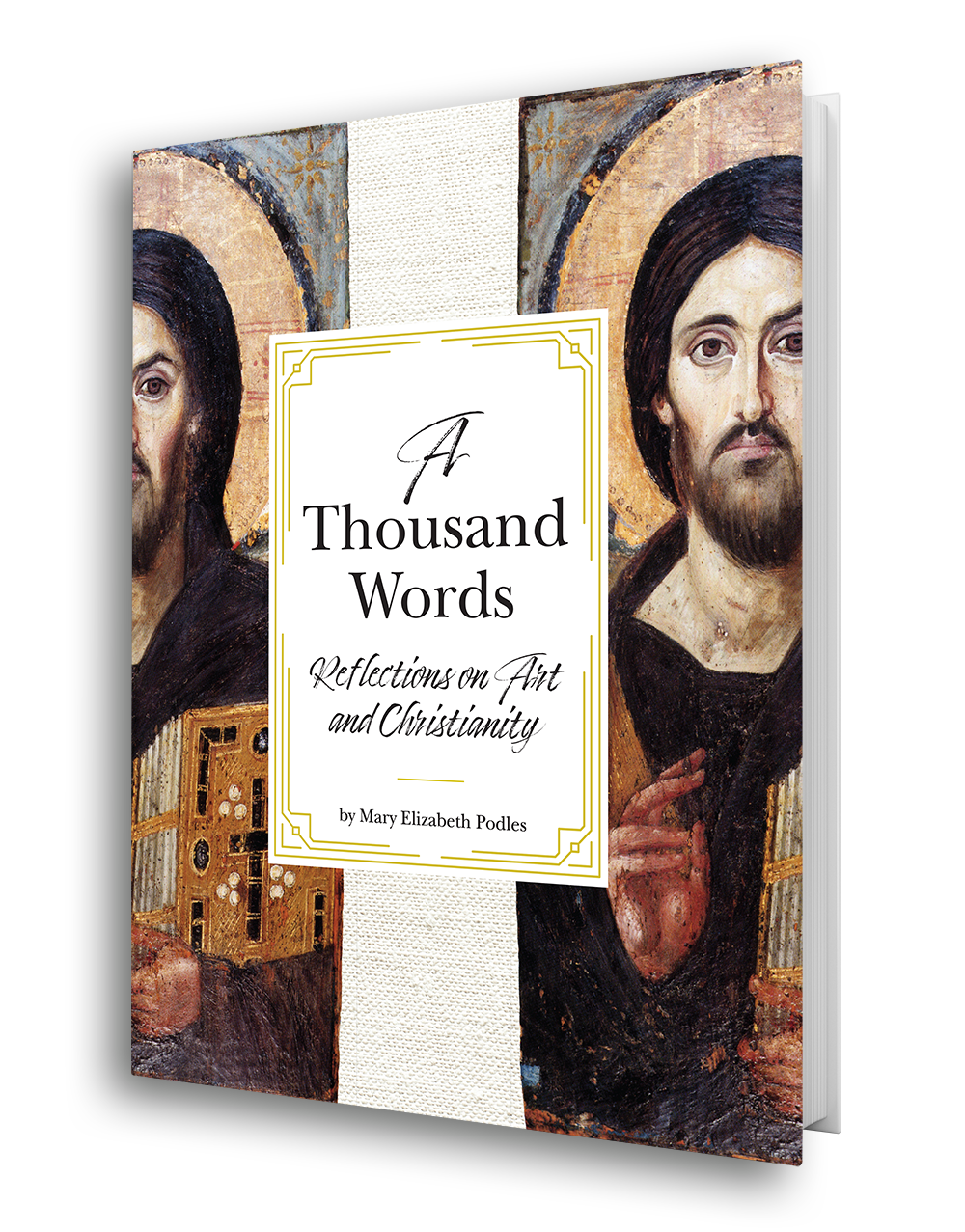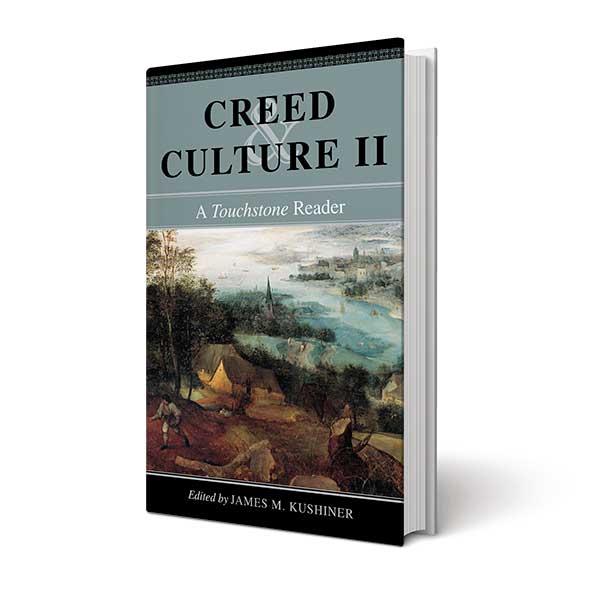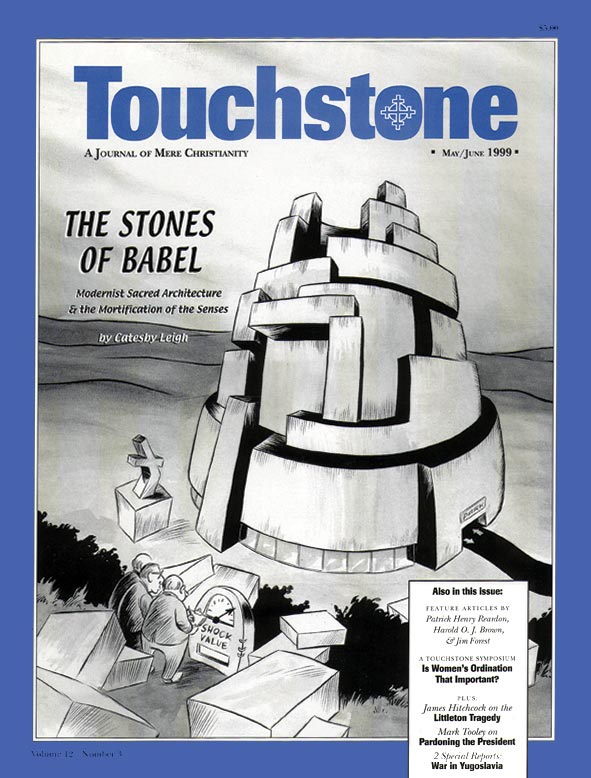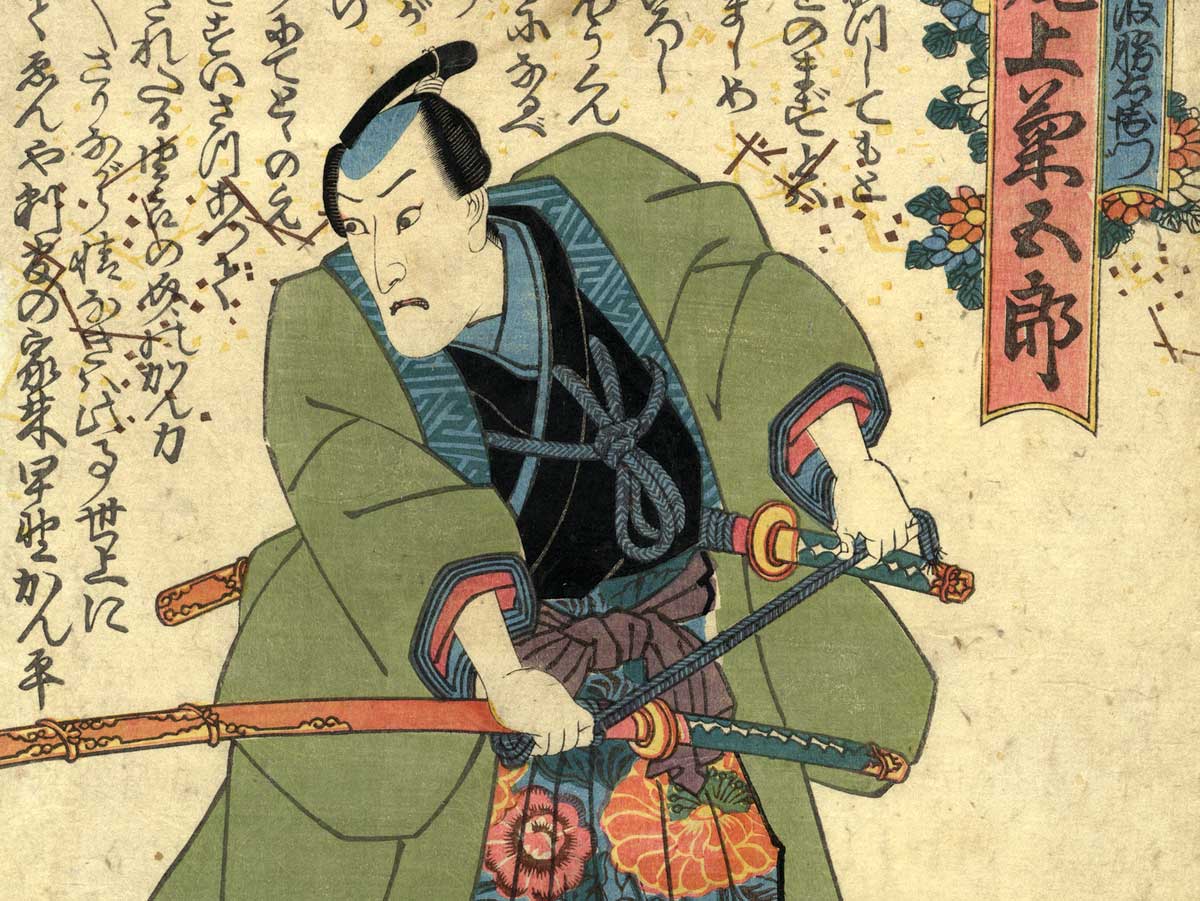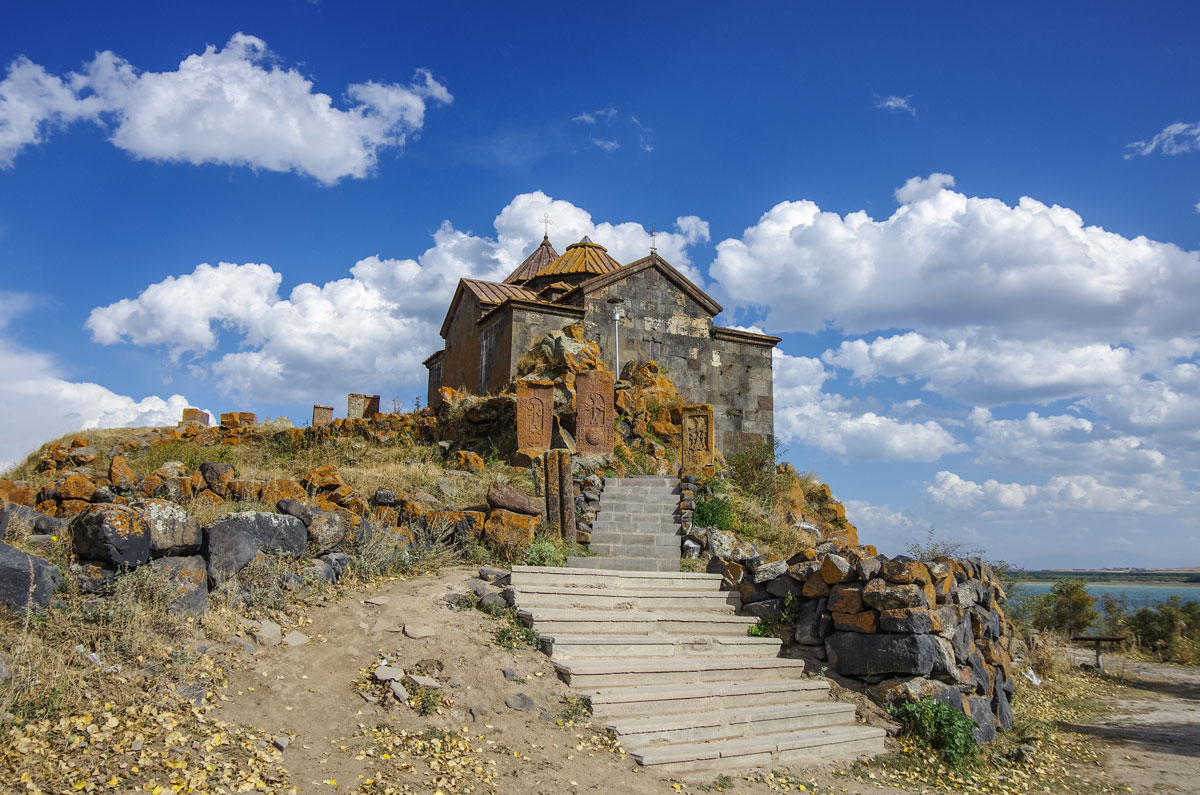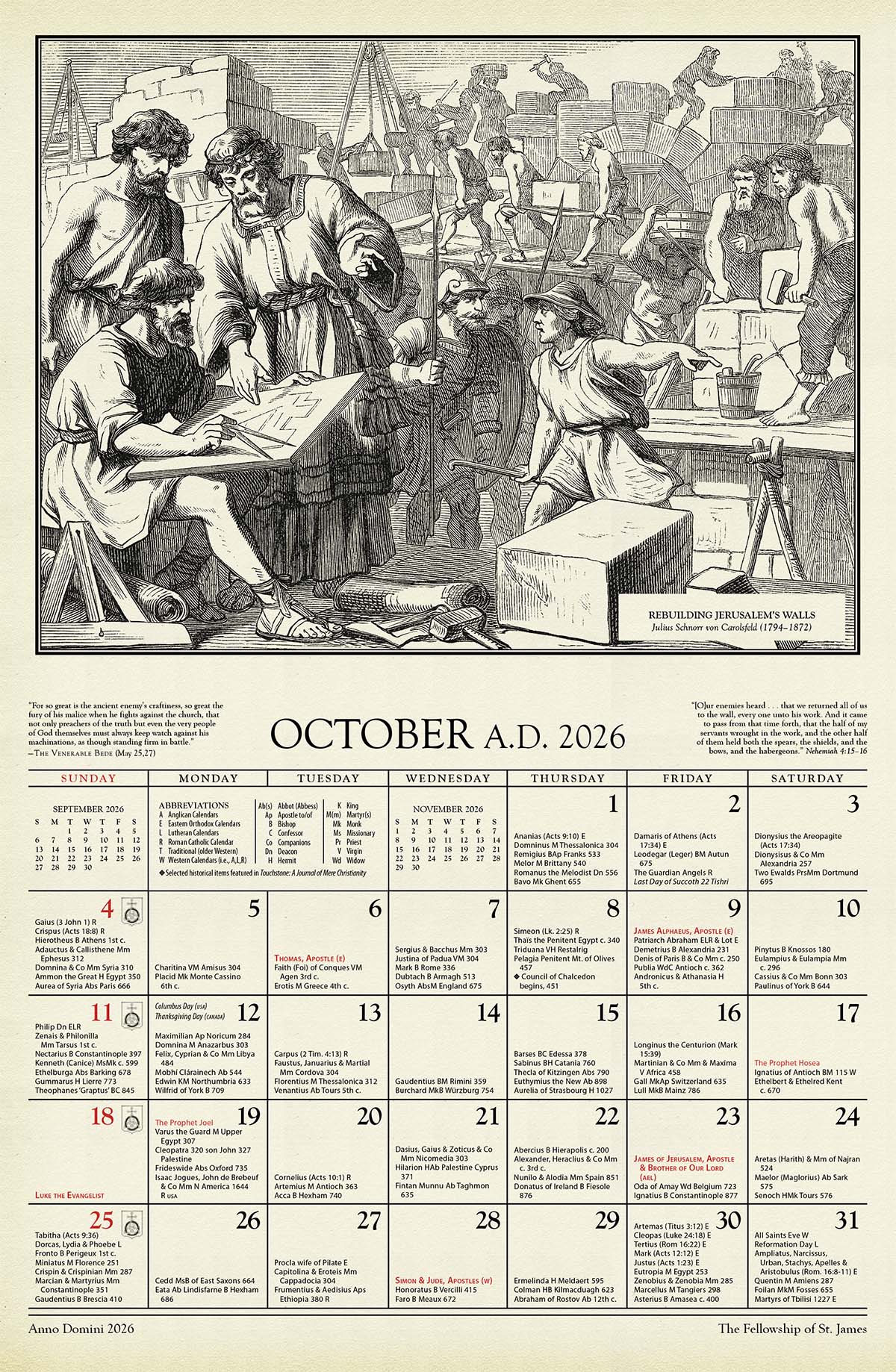Christian Types, Christian Virtues, Christian Unity
The Evangelical Path to Christian Unity
by Jim Forest
“Christian Types, Christian Virtues, Christian Unity”: my talk’s title is almost as long as a freight train. C. S. Lewis—for many of us, St. Clive, senior publisher of Touchstone—would have surely done better. I suspect he is always present at gatherings of the Fellowship of St. James. That isn’t incense you smell, that’s Lewis’s pipe.
Then there is the unquestioned presence here of the Fellowship’s patron saint and my own namesake, St. James, brother of the Lord, first bishop of Jerusalem, and one of the authors of the New Testament. We have just participated in the vespers of his feast day. St. James: the first bishop of the undivided Church, a man whose writings proclaim his sensitivity to all that threatens unity—primarily the inflammable human tongue, which can so easily put a dragon to shame.
Our theme is Christian unity. May all the saints, canonized and uncanonized, protect whomever dares to speak on this subject. He is bound to offend some if not many in the range of his voice. Especially in the Orthodox Church today, there are few topics where the ice is so thin. It’s not unusual to find those I am in communion with exclaiming, at times ranting, against “the ecumenical heresy.” Some of the e-mail that has been sent to me on this topic has enough heat in it to melt the polar ice cap. I can imagine that the ecumenical patriarch, a man besieged on many fronts, must at times wonder if his very title doesn’t require urgent revision.
Five Types
What has made me think lately about Christian “types” is an essay — “Types of Religious Lives”—written in 1937 by Mother Maria Skobtsova. You may know her as Mother Maria of Paris, an Orthodox martyr of the Second World War. She was among the flood of Russians who came to France after the Revolution. Eventually she became a nun whose main work was hospitality and defense of the poor. She was also associated with theological dialogue which, though it centered on the Orthodox Church, often had an ecumenical dimension, not unlike the Fellowship of St. James. In the Sunday afternoon theological discussions that often took place with Mother Maria as hostess, you would often find both Nicolai Berdyaev and Jacques Maritain. When the Nazis occupied Paris, she was notable in her efforts to protect Jews. She died at Ravensbruck concentration camp in Germany on Good Friday, 1945, having taken the place of a Jewish prisoner who was being sent to her death. Mother Maria is a modern saint of hospitality in perilous times, but also one of the important voices of theological life in the Orthodox Church in this fast-ending, war-wracked century.
Her essay, only recently discovered and published for the first time just a few months ago, identifies five “types” of Christian piety in the Russian Orthodox Church, but one doesn’t have to be Russian Orthodox for her analysis to strike home.
The Synodalist
First on her list is the “synodal” believer. This means state-conformed, state-contained Christianity. “Synodal” refers to the “Holy Synod” set up by Czar Peter the Great after he abolished the office of the patriarchate so that the state would have uncontested authority over its subjects in all aspects of life. Thus ended the Byzantine “symphony” of church and state. The Holy Synod governed the Church, the Chief Procurator—a layman—governed the Holy Synod, and the czar appointed and supervised the Chief Procurator. Every major church activity and appointment required the government’s sanction. The Church was, in effect, a department of government. Russia’s “synodal Christianity” is a particular form of nationally adapted, established Christianity.
Mother Maria comments:
[While] on the surface there was an official State-sanctioned religiosity, spiritual life was pushed back. . . . From generation to generation people were inculcated with the idea that the Church is of the utmost importance . . . but . . . an attribute of the State. Piety was one of the State virtues, necessary for the State’s need to have pious people. The priest was the State-appointed supervisor to look after the correct performance of religious functions by the religiously subject person. . . . It is difficult and even impossible to see Christ, to experience a Christianization of life, where the principle of the secularization of the Church is openly proclaimed. This type of piety could not cope with the difficult task of rendering to God what is God’s and what is Caesar’s to Caesar. During its lengthy existence it more and more often let Caesar be triumphant.
Our own situation is very different. We have no established church, still less a state bureaucracy supervising the activities of churches. Yet we know quite well that form of Christianity that is wrapped in the national flag and those people for whom there is no higher human destiny than to belong to a particular nation and, in the context of that primary blessing, to be a Christian. For us too, the Church can become an ornament of national identity.
The Ritualist
Next, Mother Maria identifies the “strict ritualist.” For the strict ritualist, Christ came into the world to create a community whose function was the performance of religious services and rituals that must be maintained in every detail. In Russia we have to this day a sectarian movement of “Old Ritualists” whose adherents several hundred years ago suffered greatly in defense of the custom of crossing themselves with two fingers extended rather than three. Mother Maria comments:
The greatest desire [of the strict ritualist] is for absolute spiritual order, the complete subordination of the inner life to the external rhythm which has been elaborately worked out to the minutest detail. The external rhythm encompasses everything within itself. . . . [H]e knows the spiritual significance of every detail of life, he maintains the fasts, he lives day in and day out maintaining the Church’s cycle of services. He lights vigil lamps at prescribed times. He makes the sign of the Cross correctly. . . . [He] permits no deviation from established gestures. He kneels at the proper moment during services, he bows and crosses himself at the proper time. . . . He is angry and indignant if anything is omitted during Church services. . . . [Yet] he is completely indifferent if what is being read is incomprehensible. . . . [Only] one thing which this way of life does not achieve is . . . love. . . . It cuts itself from chaos with a sturdy, prescribed and permitted cover, and chaos no longer torments it.
One need not be Orthodox to recall that within other portions of Christianity we find those who have lost themselves in the minutia of church life, those whose understanding of religious life has little if anything to do with love. In the contemporary Protestant or Roman Catholic context, in which many people are indifferent to ritual, often it is less an issue of safeguarding ritual at all costs than defending this or that school of theology.
The Esthete
Next, Mother Maria identifies the type of believer for whom “esthetical devotion” is the mainspring. For them beauty is God. In the Orthodox Church, these would be the ones who would gladly burn all icons that fall short of the standards of Theophanes the Greek and St. Andrei Rublev and who cannot bear a second-rate choir, still less congregational singing. Mother Maria comments:
Beauty and its appreciation are always the lot of a small minority—this explains the unavoidable cultural aristocracy of any esthetics. In defending the values of esthetics, a person divides the world into friends, who understand and appreciate its values, and profane enemies. [Such a person divides] all mankind into a small flock having a special esthetic sensitivity, and a crowd . . . [of] unworthies to be kept beyond the walls of the churchyard . . . [for the] mystery of the Church . . . [can] be grasped only by the elect. Not only would the sinners and the prostitutes be excluded from sitting at the feet of Christ, but all those who are too simple and naive would likewise be excluded, in order that he alone could find satisfaction from the highly esthetic beauty of Divine Services. . . . The people in the Church are looked upon as either a crowd of worshipers, essential as props for the proper rhythm of worship, or as annoying and tedious barbarians who, by their ignorance, clumsiness and occasionally by their personal sorrows and special needs, encroach upon the general grandeur and arrangement of the service. [The esthete] is afraid . . . of human woes which may lead to sympathy, he is afraid of human weakness which may lead to squeamishness. . . . [Lost in clouds of incense, they fail to notice] how Christ himself goes out, quietly and invisibly . . . to the porch and mingles with the crowd of the poor, the maimed, the cast off, the embittered, the holy fools.
Again, we are not Russians. Perhaps even we who are Orthodox can console ourselves with the thought that there is nothing remarkably beautiful about our services, little that would attract the serious esthete, no recording studios pounding on the door to record our choir or publisher eager to publish photos of our icons. Nonetheless, even the plainest Quaker Meeting House asserts a definite esthetic sensibility. However elaborate or plain our services in our particular tradition, certainly we are aware that the Church in practice can at times isolate us from those whose suffering is too manifest: “the poor, the maimed, the cast off, the embittered, the holy fools.”
Ascetical Piety
Next, Mother Maria brings us to “ascetical piety.” She points out that this is common not only among Christians but also in every religion—indeed without asceticism, every religion is in decay. Mother Maria herself followed a strict ascetic path. Nonetheless, she warns us of the dangers of asceticism that is not centered in God’s love and mercy:
Asceticism [can be a path of] attainment of special attributes of power over the soul and over nature. . . . Just as a gymnast must exercise to achieve dexterity, just as a wrestler must follow a specific regimen to develop his muscular strength, just as a singer must practice scales in order to perfect his voice, so must the ascetic of this type follow specific directions, must exercise, must repeat the same routine over and over, maintain a special diet, sensibly schedule his time, curb his habits, control his life, all this to develop to the maximum those forces with which he has been endowed by nature.
This can be christianized so that even acts of love are loveless, nothing more than a harsh obedience, the putting on the hair shirt of meeting the needs of others so that, having crucified my flesh, I may finally be among those who are saved. Such a person realizes he is obliged to be merciful and therefore he is merciful. He is attentive to human misery and performs the works of mercy with diligence. “But,” notes Mother Maria,
if you pay careful attention, you will discern that he does all this not because of a self-renouncing and sacrificial love, laying down his soul for his friends, but as an ascetical exercise. This is how his own soul is trained to save itself. . . . Such an ascetical rejection of the world is nothing more than . . . an intolerable act of self-preservation. . . . [and] spiritual egocentrism.
Mother Maria contrasts this self-centered asceticism with a deeper, more difficult asceticism, the asceticism of love and spiritual poverty such as we see in Mary, the Mother of God, who says, “Behold the handmaid of the Lord.” These words, Mother Maria comments, “determine the whole essence of the Christian soul.”
The Evangelical
Which brings us to her last and highest “type,” the Christian who walks “the evangelical path.” By “evangelical,” Mother Maria was not referring to Protestant evangelicalism, which she regarded as a sectarian distortion of the gospel.
She continues:
The Evangelical way of spiritual life . . . is as eternal as is the proclamation of the Good News, always alive within the bosom of the Church, radiant in the faces of saints and at times extending that radiance even to those righteous people outside the Church. The Evangelical spirit of religious consciousness breathes where it wills, but woe to those ages and to those people upon which he does not rest. And along with this, blessed are those who walk in his paths, even those who know it not.
She asks what is the most characteristic thing about this path. “It is a desire to ‘Christify’ all life.” This, she adds, is not the same thing as to “Churchify” life or even the christianization of society, if by this is meant simply the correction of “the bestial cruelty of man’s history” by “inoculating it with a certain dose of Christian morality.” Christification has to do with the roots of being: “It is no longer I who live, but Christ who lives in me.”
The image of God, the icon of Christ, which truly is my real and actual essence, is the only measure of things, the only way which is given to me. Each movement of my soul, each approach to God, to people, to the world, is determined by the suitability of that act for reflecting that image of God which is within me. If I am faced with two choices and I am in doubt, if all human wisdom, experience, and tradition point to one of these, but I feel that Christ would have chosen the other—then all my doubts should immediately disappear and I would choose to follow Christ in spite of all experience, tradition and wisdom to the contrary.
Apart from the consciousness that Christ is calling me to a definite path, she asks what objective signs might ratify a particular leading, for there is always the danger that I am simply imagining God’s will. Here she points to the two commandments Christ has given us: to love God and to love our fellow man.
Everything else, even the Beatitudes, are merely elaborations of the two commandments which contain within themselves the totality of Christ’s Good News. Furthermore, Christ’s earthly life is nothing other than the revelation of the mystery of love toward God and toward man. These are, in effect, not only the true, but the only, measure of things. It is remarkable that their truth is found only in their indissolubility. Love for man alone leads us to the blind alley of anti-Christian humanism and the only way out of it is, at times, to reject man and love toward him in the name all of mankind. But love for God without love for man is condemned: “You hypocrite, how can you love God whom you have not seen, if you hate your brother whom you have seen.” Their linkage is not simply a combination of two great truths taken from two spiritual worlds but . . . a union of two parts of a single whole. . . . Destroy either one and you destroy the whole truth. In fact, take away the love for man and you destroy the man (because by not loving him you reject him, you make of him a nonbeing) and you no longer have a path toward the knowledge of God. God then truly becomes apophatic; only negative signs are attributed to Him and even these are stated in your negative human expressions. He becomes inaccessible to your human soul because, in rejecting man, you reject humanity and you reject that which is human in your own soul, the very humanity which is the image of God within you, which is your only means to gaze at the Prototype. Needless to say, the human person of Christ taught you in his own human language, describing God’s truth in human terms, that God reveals Himself through human concepts. Not loving, not having contact with humanity, we transform ourselves into a kind of a deaf-mute blindness with respect to the Divine as well. In this sense, not only did the Logos-Word-Son of God assume human nature to complete his work of redemption and by this, once and for all, sanctifying it and predestining it for Deification, but the Word of God, as the Good News, as revelation and enlightenment, likewise needed to become incarnate in the body of man’s insignificant language.
Love & Language
Here we return, on this evening of the feast of St. James, to the tongue and the words it shapes, the tongue that God gave us as a means of dialogue and therefore communion with each other, and that we instead so often use as a means of breaking communion and even causing war. As James writes: “The tongue is only a tiny part of the body, but it can proudly claim that it does great things. Think how small a flame can set fire to a great forest. The tongue is a flame like that”—a flame that bears the fire of hell and is capable of “setting fire to the whole wheel of creation. . . . We use the tongue to bless the Lord and Father, but also to curse men who are made in God’s image.” In this we who are children of the Father of light make ourselves into children of darkness.
A huge part of all labor for unity is therefore care for language and awareness of whom we are serving with our words. “It is with language,” wrote Mother Maria, “that people express their feelings, doubts, thoughts, good deeds and sins. In this way human speech, being the symbol of man’s interior life, was likewise sanctified and grace-filled, affecting the whole interior life of man.”
Language is one of our primary tools for the communication of love. But expressing love for our fellow creatures is ultimately impossible if it is love that has no mystical dimension, for as Mother Maria asks:
What can we love in man if we do not discern God’s image within him? Without that image what is such love based on? It becomes a kind of a special, monstrous egoism in which everyone else becomes a particular facet of my own self. I love that in him which is compatible with me, which broadens me, which explains and which at times simply amuses and delights me. If, however, this is not so, if indeed this is a selfless, nonreligious love toward man, then it invariably will move from a specific person with flesh and blood and turn toward the abstract man, toward humanity, even to the concept of humanity and almost always result in the sacrifice of an individual concrete person upon the altar of this abstract idea, the common good, the earthly paradise, etc.
Love is not the easiest word to use in this era, given that its primary definition in general usage has to do with romantic love and thus is less about what we do, how we relate to each other and to God than what we feel in an enclosed relationship. The word “love” is like an icon that has been darkened by many decades of smoke so that we can hardly make out the original lines and can only guess at the hidden colors. The icon needs to be restored. But even when love can be correctly defined, there is the problem of our fear of love, our fear of a life in which the primary factor is one’s effort to become more aware of the image of God in the other. There is therefore always a tendency to objectify both God and man.
There is that famous epiphany in the life of Thomas Merton when he happened to be waiting for a traffic light to change at a certain intersection in downtown Louisville one day in 1958 and was suddenly stricken with the realization that he loved all these people. “It was like waking from a dream of separateness,” he commented afterward. He goes on to comment that the only problem about being in a state of such mystical awareness of God’s image in each person is that we would have to spend our lives on our knees. He seemed still to be standing at the same intersection years later, weeks before his death in 1968, when he wrote that “we all stand on the hidden ground of love.”
An Alternative Search for Unity
No doubt Merton would recognize and appreciate the various “types” Mother Maria distinguished, readily identifying their counterparts in the Roman Catholic Church. For those in the first four categories, unity is out of the question. It is less a matter of defending ultimate theological truths than attachment to national identity, tribe, custom, the grudges of history, etc. In any event, the dimension of love is missing and in its place one finds contempt.
Regarding the fifth, Evangelical type, it is likely Merton would have seen Dorothy Day as such a person: someone in whom the love of God and man were even less apart than two sides of the same coin. Had he known about Mother Maria, she would be another.
We see in Mother Maria, in Thomas Merton, in Dorothy Day, in C. S. Lewis, a recognition that even within a particular family of believers, using the same prayers, reciting the same creed, using the same rituals, called to a similar asceticism, each of us to some extent is one or more types and that what Mother Maria refers to as the “evangelical” level is not necessarily the most densely populated area, and that we too may be among those who aren’t there yet: our temperaments, our careers, our irritations, our tastes, our own tribalism, and God knows what else, get in the way.
There are, of course, also the chasms left by church history, heresies still active. There is the matter of the truth and the responsibility to safeguard as best we can the “faith handed down to the Apostles.” These problems are not overcome even by torrents of good will or even by saintly, Christ-like love. It is not enough to say that “we all stand on the hidden ground of love, therefore there is no problem,” and go have a friendly beer and tell jokes about the minister, the priest, and the rabbi.
But without Christ-like love, without the attentive search for God’s image in the other, there is no beginning point. Scolding fingers, brilliant lectures, stunning rebuttals—none of this will bring us closer if we simply are glaring at each other.
St. James saw the tongue as the great obstacle, the tiny rudder that can so easily move a great ship in the wrong direction. His letter to the twelve tribes in the diaspora is a powerful caution to those of us who are rarely lost for words. Those who teach, he warns us, are subject to a stricter judgment. But James offers no similar warning about our ears. May God bless our ears, pacify our tongues, warm our hearts, and illumine our souls.
Note:
The full text of the essay by Mother Maria, as translated from the Russian by Fr. Alvian Smirensky, is posted on the Orthodox Peace Fellowship website.
This article was originally given as a lecture sponsored by the Fellowship of St. James at All Saints Orthodox Church in Chicago on October 22, 1998.
Jim Forest is secretary of the Orthodox Peace Fellowship and edits its publication, “In Communion.” He is the author of many books, including Praying with Icons and Living with Wisdom: A Biography of Thomas Merton. He has lectured at hundreds of parishes and colleges, and has led retreats at centers in both the USA and England. He and his wife Nancy have six children and make their home in Alkmaar, Holland, a city northwest of Amsterdam.
subscription options
Order
Print/Online Subscription
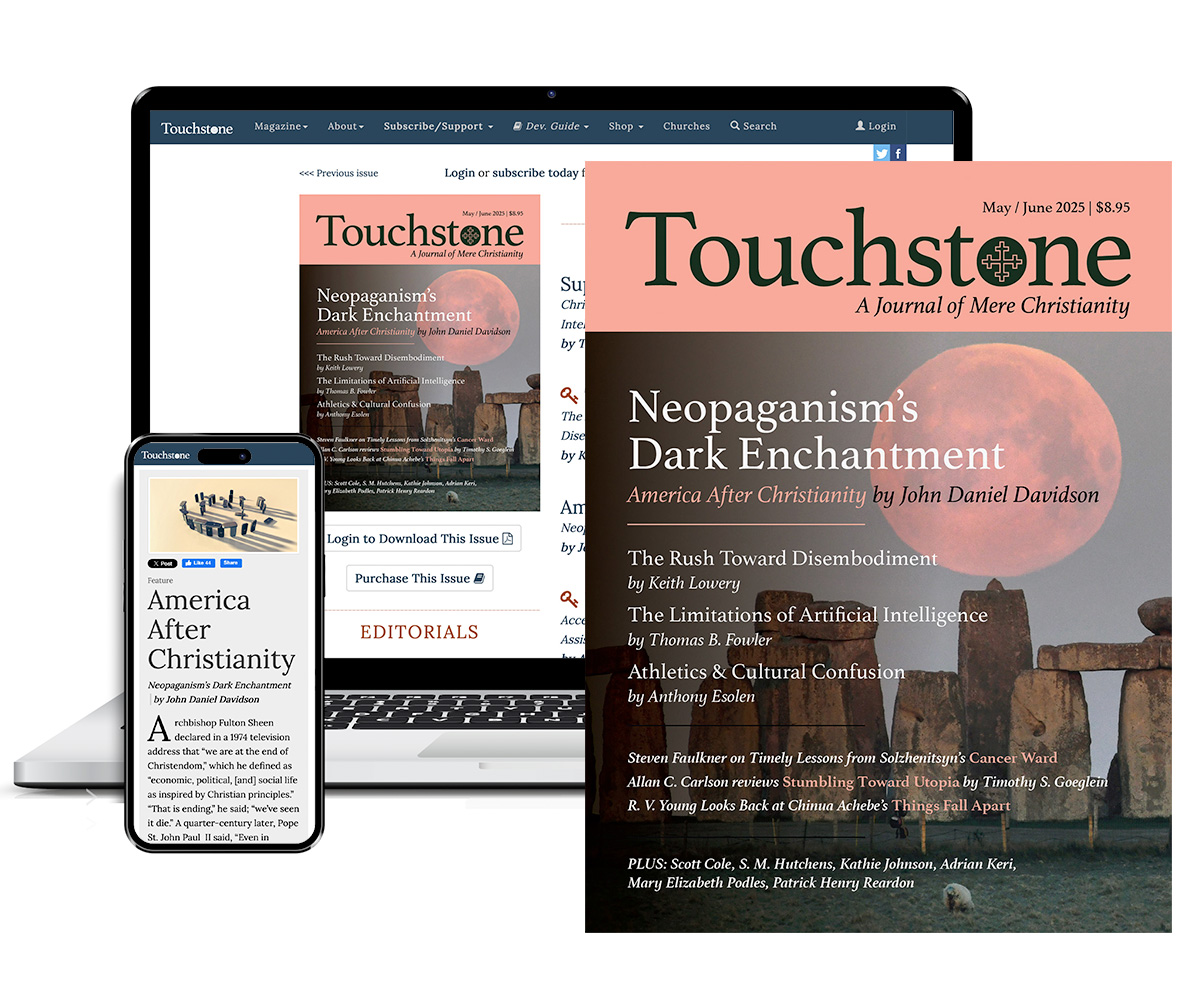
Get six issues (one year) of Touchstone PLUS full online access including pdf downloads for only $39.95. That's only $3.34 per month!
Order
Online Only
Subscription

Get a one-year full-access subscription to the Touchstone online archives for only $19.95. That's only $1.66 per month!
bulk subscriptions
Order Touchstone subscriptions in bulk and save $10 per sub! Each subscription includes 6 issues of Touchstone plus full online access to touchstonemag.com—including archives, videos, and pdf downloads of recent issues for only $29.95 each! Great for churches or study groups.
Transactions will be processed on a secure server.
more from the online archives

24.6—Nov/Dec 2011
Liberty, Conscience & Autonomy
How the Culture War of the Roaring Twenties Set the Stage for Today’s Catholic & Evangelical Alliance by Barry Hankins
calling all readers
Please Donate
"There are magazines worth reading but few worth saving . . . Touchstone is just such a magazine."
—Alice von Hildebrand
"Here we do not concede one square millimeter of territory to falsehood, folly, contemporary sentimentality, or fashion. We speak the truth, and let God be our judge. . . . Touchstone is the one committedly Christian conservative journal."
—Anthony Esolen, Touchstone senior editor



